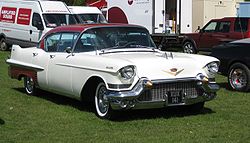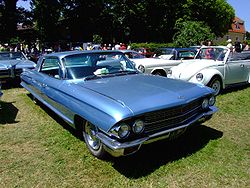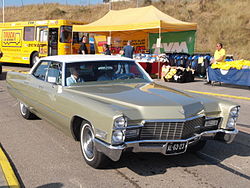- Cadillac Sedan de Ville
-
"deVille" and "De Ville" redirect here. For other uses, see Deville.
Cadillac de Ville 
Manufacturer General Motors Production 1949–2005 Assembly Detroit, Michigan, United States Predecessor Cadillac Series 62 Successor Cadillac DTS Class Full-size luxury car The de Ville was originally a trim level and later a model of General Motors' Cadillac marque. The first car to bear the name was the 1949 Coupe de Ville, a prestige trim level of the Series 62 luxury coupe. The last model to be formally known as a de Ville was the 2005 Cadillac Deville, a full-size sedan, the largest car in the Cadillac model range at the time. The next year, the Deville was officially renamed DTS (an abbreviation standing for Deville Touring Sedan, itself a trim level on earlier models).
Contents
Origin
The name "de Ville" (French: "of the city" or "town",) is a reference to the town car body style, which featured an open chauffeur's compartment and an enclosed passenger compartment. The term was also used by Lincoln in 1922, to describe a one-off model built for Henry Ford.[1] In Cadillac parlance, de Ville was first used to designate a deluxe trim level on hardtop or "pillarless"-body cars. At first, de Ville trim was available only on the Series 62, but pillared sedans were not available in de Ville trim until the 1965 model year, when de Ville became an independent trim line, including a convertible and pillared sedan.
1956
First generation 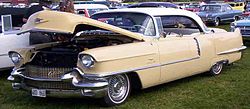
1956 Cadillac Sedan De VilleProduction 1956 Assembly Detroit, Michigan, USA Body style 4-door hardtop Layout FR layout Platform C-body Engine 365 cu in (6.0 L) V8 Transmission automatic Wheelbase 129.0 in (3,277 mm) Length 214.9 in (5,458 mm) Related Cadillac 62
Buick Roadmaster
Buick Super
Oldsmobile 98Designer Harley Earl The first Cadillac Sedan de Ville was a 4-door hardtop version appearing in 1956 (a one-off Sedan de Ville was built in 1954).[2]) Both cars were based on the Series 62.
1957–1958
Second generation
1957 Cadillac Sedan De VilleProduction 1957–1958 Body style 4-door hardtop Layout FR layout Engine 331 cu in (5.4 L) V8
365 cu in (6.0 L) V8Wheelbase 129.5 in (3,289 mm) Length 1957: 215.9 in (5,484 mm)
1958: 221.8 in (5,634 mm)1959–1960
Third generation 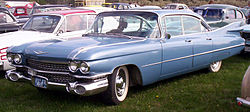
1959 Cadillac Sedan De VilleProduction 1959–1960 Assembly Detroit, Michigan, USA Body style 4-door hardtop Layout FR layout Platform C-body Engine 390 cu in (6.4 L) V8 Transmission 4 Speed GM "Hydra Matic" Automatic Wheelbase 130.0 in (3,302 mm) Length 225.0 in (5,715 mm) Width 80.7 Height 54.4 Curb weight 4,460-4,690 Related Cadillac 62
Buick Electra
Oldsmobile 98Designer Bill Mitchell 1961–1964
Fourth generation
1962 Cadillac Sedan De VilleProduction 1961–1964 Body style 4-door hardtop (no b-pillar)[3] Layout FR layout Engine 390 cu in (6.4 L) V8
429 cu in (7.0 L) V8Wheelbase 129.5 in (3,289 mm) Length 1961–62: 222.0 in (5,639 mm)
1963: 223.0 in (5,664 mm)
1964: 223.5 in (5,677 mm)1965–1970
Fifth generation
1968 Cadillac Sedan De VilleProduction 1965–1970 Body style 4-door hardtop (no b-pillar)
4-door sedan[4]Layout FR layout Engine 429 cu in (7.0 L) V8
472 cu in (7.7 L) V8Transmission 3-speed automatic Wheelbase 129.5 in (3,290 mm) Length 1965–66: 224.0 in (5,690 mm)
1967–68: 224.7 in (5,710 mm)
1969–70: 225.0 in (5,715 mm)Beginning in 1965, de Ville denoted Cadillac's mainstream model, falling between the Calais and the Fleetwood.
All GM fullsize lines were completely redesigned for 1965, yet de Ville retained its 129.5-inch (3,290 mm) wheelbase. The Series 62 on which the de Ville was based was now called Calais. Rounded body styling gave way for sharp, angled lines. Tailfins disappeared, and headlights were now stacked vertically allowing for a wider grille. The pillared sedan variant returned. Power was still supplied by the 429 cu in (7,030 cc) V8, which was replaced by the 472 cu in (7,730 cc) for 1968.
For 1968, the de Ville gained slight exterior changes to comply with new federal safety and emissions legislation, and as with the rest of the Cadillac lineup, a new 472 cu in (7,730 cc) V8 engine rated at 375 hp (SAE gross). 1968 was also the last year for the "stacked" dual headlights, which were replaced with side-by-side dual headlights in 1969.
1971–1976
Sixth generation
1971 Cadillac Sedan De VilleProduction 1971-1976 Assembly Detroit, Michigan, USA
Linden, New Jersey, USABody style 4-door hardtop[5] Layout FR layout Platform C-body Engine 472 cu in (7.7 L) V8
500 cu in (8.2 L) V8Transmission 3-speed TH-400, automatic Wheelbase 130.0 in (3,302 mm) Length 1971-72: 225.8 in (5,735 mm)
1973: 227.8 in (5,786 mm)
1974–76: 230.7 in (5,860 mm)Width 79.8 in (2,027 mm) Height 54.3 in (1,379 mm) Curb weight 4,900–5,400 lb (2,200–2,400 kg) Related Cadillac Calais
Buick Electra
Oldsmobile 98Designer Bill Mitchell As with all GM full-size lines, the de Ville was redesigned for 1971. The standard engine remained the 472, still rated at 375 SAE gross horsepower and 365 ft·lbf (495 N·m) of torque. The car was still essentially a Calais with more options and different exterior trim.
In November 1971, a showroom-stock 1971 Coupe de Ville placed third in the annual coast-to-coast Cannonball Run, posting the highest average speed of the event, 84.6 mph (136.2 km/h) (excluding stops) and averaging 8.9 mpg-US (26 L/100 km; 10.7 mpg-imp).
The front end was redesigned with the newly approved quad rectangular headlamps for 1975. The 210 hp 500 V8 replaced the 472 as the standard engine. 1974 saw the introduction of the optional "Air Cushion Restraint System". Known today as airbags, this option provided protection for front seat occupants in the case of a frontal collision. One bag was located in the steering wheel, the other in the dashboard in front of the front seat passenger. The glove box was replaced with a lockable storage compartment under the dashboard. After the 1976 model year it was not offered.
The de Ville "d'Elegance" Package- In 1974, the De Ville series was available with the optional "d'Elegance" package. Similar to the Fleetwood Brougham's package of the same name, it offered a velour seating fabric, upgraded carpeting, and exterior badging. The package was available on both coupe and sedan models. The "d'Elegance" name remained with the de Ville series as a package through 1984. In 1997 it became a separate model designation for the sedan.
1977–1984
Seventh generation 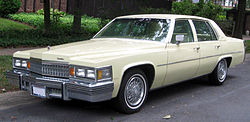
Production 1977–1984 Body style 4-door sedan Layout FR layout Engine 7.0L V8(1977–1979)
5.7L Diesel V8(1978–1985)
6.0L V8(1980–1981)
4.1L V6 (1980–1982)
4.1L V8(1982–1984)Transmission 3-speed automatic (1977–1980)
4-speed automatic(1981–1984)Wheelbase 1977–79: 121.5 in (3,086 mm)
1980–84: 121.4 in (3,084 mm)Length 1980–84: 221.0 in (5,613 mm)
1977–79: 221.2 in (5,618 mm)Width 1983–84: 75.3 in (1,913 mm)
1980–84: 76.4 in (1,941 mm)
1977–79: 74.6 in (1,895 mm)Height 1983–84: 55.5 in (1,410 mm)
1980–82: 55.6 in (1,412 mm)
1977–79: 55.3 in (1,405 mm)1977 was Cadillac's 75th anniversary, and saw the introduction of the downsized de Ville coupes and sedans. These new cars featured a higher roofline, resulting in a vehicle that was nearly a foot shorter, over three inches narrower, and 1/2 ton lighter than last year, but with a larger trunk and more headroom and legroom. These were also the first de Ville models since its introduction in 1949 to be marketed without fender skirts over the rear wheels. The 500 in³ V8 (which produced 190 horsepower) was replaced for '77 by a 180 horsepower 425 in³ V8 variant of similar design.
Size comparison between 1974 and 1977 Cadillac Sedan de Ville
1974 Cadillac Sedan de Ville 1977 Cadillac Sedan de Ville Wheelbase 130.0 in (3,302 mm) 121.5 in (3,086 mm) Overall Length 230.7 in (5,860 mm) 221.2 in (5,618 mm) Width 79.8 in (2,027 mm) 76.4 in (1,941 mm) Height 54.3 in (1,379 mm) 55.3 in (1,405 mm) Front Headroom 39.2 in (996 mm) 39.0 in (991 mm) Front Legroom 41.9 in (1,064 mm) 42.0 in (1,067 mm) Front Hip Room 57.8 in (1,468 mm) 55.0 in (1,397 mm) Front Shoulder Room 62.1 in (1,577 mm) 59.4 in (1,509 mm) Rear Headroom 38.2 in (970 mm) 38.1 in (968 mm) Rear Legroom–ins. 40.1 in (1,019 mm) 41.2 in (1,046 mm) Rear Hip Room 58.0 in (1,473 mm) 55.7 in (1,415 mm) Rear Shoulder Room 64.0 in (1,626 mm) 59.4 in (1,509 mm) Luggage Capacity 15.9 cu ft (450 L) 19.5 cu ft (552 L) For 1977, the line-up included the two-door Coupe de Ville ($9,654) and four-door Sedan de Ville ($9,864). The $650 d'Elegance package, an interior dress-up option carried over from the previous generation of de Villes, continued for both models. 3-sided, wrap-around tail lamps were a 1977 feature only (although they would re-appear in 1987). Coupe de Ville's popular "Cabriolet" option, priced at $348, included a rear-half padded vinyl roof covering and opera lamps. An optional electronic fuel-injected version of the standard 7.0 liter powerplant, adding 15 horsepower (11 kW), was available for an additional $647. Sales figures were 138,750 Coupe de Villes and 95,421 Sedan de Villes.
In addition to a redesigned grille and hood ornament, 1978 saw slim, vertical tail lamps inset into chrome bumper end caps with built-in side marker lamps (Cadillac would retain this "vertical tail lamp inset" design feature on de Ville through 1984, and again from 1989 through 1999). New for 1978, a "Phaeton" package was optional for de Ville. Available on both coupe and sedan, the $1,929 Phaeton package featured a simulated convertible-top, special pin striping, wire wheel discs, and "Phaeton" name plates in place of the usual "Coupe de Ville" or "Sedan de Ville" ornament on the rear fenders. Inside were leather upholstered seats and a leather-trimmed steering wheel matching the exterior color. The package was available in "Cotillion White" (with Dark Blue roof), "Platinum Silver" (with a Black roof), or "Arizona Beige" (with a Dark Brown roof). Coupe de Ville's popular Cabriolet roof package was priced at $369, while the d'Elegance package (for coupe or sedan) was available at $689. Electronic fuel injection, which added 15 horsepower (11 kW), was available at $744. Electronic level control - which used suspension-mounted sensors and air filled rear shocks - kept the car's height level regardless of passengers and cargo weight, was available for $140. Sales dropped slightly from 1977 to 117,750 for the $10,444 Coupe de Ville, and 88,951 for Sedan de Ville, priced at $10,668.
With bigger changes coming in '80, the 1979 models saw few alterations, one of which was a new grille design. The "Phaeton" package, now priced at $2,029, was still available in three colors, but with two new replacement colors: "Western Saddle Firemist" (with leather interior in "Antique Saddle") replacing the "Arizona Beige", and "Slate Firemist" (with leather interior in "Antique Gray") replacing "Platinum Silver". The d'Elegance package was back, at $725, which included Venetian velour upholstery (in four colors) with a 50/50 split front seat, overhead assist handles, Tangier carpeting, door pull handles, and "d'Elegance" emblems among other niceties. In addition to the $783 "fuel-injection" option, there was also the choice of a 350 in³ LF9 diesel V8 (built by Oldsmobile) for $849. Coupe de Ville's cabriolet package, priced at $384, was available in 17 colors. Production rose slightly to 121,890 for Coupe de Ville ($11,728), and 93,211 for Sedan de Ville ($12,093).
1980 saw a significant refresh, with a lower, more aerodynamic nose, higher tail end, and a heavier, more substantial appearance. The Phaeton option was discontinued, but the $1,005 d'Elegance package remained. The Coupe de Ville now wore full, bright side window surround moldings, whereas the sedan had body-color door frames with a thin chrome bead around the window opening (as used in 1977 - 1979). The chromed-plastic grille held a very diplomatic, Rolls-Royce inspired design, with thick vertical bars. The grille cast for 1980 was used again for the 1989 to 1992 Cadillac Brougham. Late in the 1980 model year, V6 power (in the form of a 4-bbl 252 CID engine manufactured by Buick) was offered as a credit option. Cadillac had not offered an engine with fewer than 8 cylinders since 1914. The standard engine for 1980 was a new 368 CID (6.0 L) V8. Unlike the pre-1980 models, the rear window glass for both two and four door models was now the same, as the two door models did away with the sporty slanted rear window and adopted the formal vertical look shared with the sedans. Pricing for de Ville was $12,899 for the coupe; $13,282 for the sedan. Sales dropped miserably for the 1980 model year, despite new sheetmetal and a multitude of improvements. Coupe de Ville was down to 55,490 (less than half of the '79 figures), Sedan de Ville was also down by nearly half at 49,188. Oldsmobile's 5.7 liter diesel V8 was still available at $924, as was the popular Cabriolet option for Coupe de Ville at $350.
1981's biggest news was the introduction of Cadillac's modulated-displacement 368 in³ V8-6-4 engine. Developed by the Eaton Corporation - with design elements that had been tested for over 500,000 miles (800,000 km) - allowed various engine computers to decide how many cylinders were needed to power the car for optimal fuel economy. The theory was 8 cylinders from a complete stop, 6 cylinders during usual driving, and just four cylinders at cruising speed. The changes in cylinder operation were seamless, and most drivers did not detect any difference in operation. However, in some cases, reliability and component failure led to customer complaints. Cadillac defended its micro-compressor controlled powerplant, and even offered special extended warranties to customers. Also available was Oldsmobile's 5.7 liter V-8 diesel engine. The 125 horsepower (93 kW) Buick V6, teamed with an automatic transmission, returned for '81 after a short initial offering in the spring of 1980. Coupe de Ville was priced at $13,450, while Sedan de Ville, priced at $13,847, now had the unique option of an available automatic seat belt system - the first offered on a GM vehicle. With the automatic shoulder/lap belt system (only for the outboard front seat passengers), the shoulder point was moved from the upper B-pillar to the upper door glass frame, and the belt reel was moved from the floor onto the door itself, installed in the lower corner. With this, you could theoretically leave the seat belt latched at all times, and simply get in and out of the vehicle without having to unfasten the belt. The $150 option (which would re-appear as standard equipment on the 1990 - 1992 Brougham), was available only on V6-powered Sedan de Villes. The V6 option itself was a $165 credit over the standard V8 in de Ville. A new grille design was made up of small squares, similar to the pattern from 1979. The egg-crate 1981 grille cast was used again for the 1987 and 1988 Cadillac Brougham models. A new Electronic Climate Control panel did away with the slide lever and thumb wheel in favor of a digital display which allowed the driver to set the interior temperature to a single degree - from 65 to 85 (or "max" settings at 60 and 90 degrees). Option groups included the $1,005 d'Elegance package (available on both models), and the Cabriolet package (for Coupe de Ville) at $363. Sales were up slightly from 1980–89,991 sedans versus 62,724 coupes (figures include de Ville and Fleetwood models).
Changes for '82 were kept to a minimum, but still included a new grille design (which was used through 1986), revamped parking lamp / tail lamp ornamentation, and a new standard wheel cover design. Cadillac introduced a new aluminum-block 249 cu 4.1 liter HT series V8 engine to replace the V8-6-4. The new power plant featured a closed-loop digital fuel injection system, free-standing cast-iron cylinders within a cast-aluminum block, and was coupled with a 4-speed automatic-overdrive transmission. Other engine options included the Buick V6 or Oldsmobile's diesel V8. Inside, the Electronic Climate Control had an updated fascia that now included an "Outside Temperature" button. Previously, the outside temperature was available through an illuminated thermometer mounted to the driver's outside mirror. With the new front-drive Cadillac Cimarron taking over as Cadillac's entry-level model, the $15,249 Coupe de Ville was now a step-up. Sedan de Ville was priced at $15,699. Sales totals for 1982 included 50,130 coupes and 86,020 sedans (figures include de Ville and Fleetwood models).
For 1983, slight reworkings under the hood added 10 horsepower (now rated at 135) to the standard 4.1 liter powerplant. Meanwhile, the Buick V6 credit-option was dropped. The biggest visible change was hardly noticeable - while the grille design was a carry-over from the previous year (and would be through 1986), the Cadillac script moved from the chrome header onto the grille itself. Coupe de Ville's popular Cabriolet roof package added $415 to its $15,970 sticker price. While both models, including the $16,441 Sedan de Ville, could be ordered with the $1,150 d'Elegance package. 1983 was supposed to be the last year for the rear-drive De Ville, as new front-drive models would take over for 1984. However, numerous developmental delays caused De Ville to stay in rear-drive form for another year. Sales figures looked healthy, with a total of 109,004 sedans and 65,670 coupes (figures include de Ville and Fleetwood models).
Because of a delay in production of the new front-drive De Villes (which were now going to be 1985 models), 1984 was a re-run for the rear-wheel drive Coupe de Ville ($17,140) and its four-door companion, the popular Sedan de Ville ($17,625). It would also be the last time De Ville used the "V" emblem below the Cadillac crest, as 1985 models and on would use the crest and wreath emblem - formerly a Fleetwood exclusive. Visible changes included body-color side moldings, and gold-tone winged crests on the parking lamps up front and tail lights in back. Hidden changes included a revised exhaust system with a revamped catalytic converter. The diesel V8 was now available at no additional charge. While the optional d'Elegance package remained at $1,150, the Cabriolet option for Coupe de Ville went up to $420. For 1984, sales figures show a total four-door production of 107,920 units, and an additional 50,840 two-door units (figures include de Ville and Fleetwood models). These figures are somewhat deceiving though, as this was a very short model year for the rear-drive Coupe and Sedan de Ville. The rear-wheel drive model sales figures - impressive for such a shortened production run - showed that buyers were not quite ready for smaller Cadillacs just yet. The new front-drive 1985 Coupe de Ville and Sedan de Ville arrived in Cadillac showrooms during the Spring of 1984, about six months earlier than most new-car introductions, so both the 1984 rear-drive and 1985 front-drive models were selling at the same time for nearly half a year. Cadillac sold 45,330 units of the new 1985 front-drive models during the 1984 model year (35,940 four-doors and 9,390 two-doors.
1985–1988
Eighth generation Production 1985–1988 Assembly Lake Orion, Michigan, USA Body style 4-door sedan Layout FF layout Platform C-body Engine 4.1 L HT-4100 V8
4.3 Diesel V6 (1985 only)
4.5 L V8Transmission 4-speed 440-T4 automatic Wheelbase 110.8 in (2,814 mm) Length 1985–86: 195.0 in (4,953 mm)
1987–88: 196.4 in (4,989 mm)Width 1985–86: 71.7 in (1,821 mm)
1987–88: 72.5 in (1,842 mm)Height 55.0 in (1,397 mm) For the 1985 model year, the deVille switched to GM's new FWD C-body platform. A Fleetwood sedan variant was added to the mix at the start of production and shared the new front-wheel drive platform and most dimensions with the deVilles (the "Fleetwood Brougham" nomenclature remained on the rear wheel drive chassis thru model year 1986). Production of the new C-body commenced December 1983 at the Orion Assembly Plant in Orion Township, Michigan. A Fleetwood coupe version of the new FWD C-body joined the lineup later in the production run. The front cover of the brochure advertised the new cars as the "Cadillac of Tomorrow". These new models were smaller externally yet kept almost identical interior dimensions as their predecessors. This change also brought nearly the entire Cadillac line of cars to front wheel drive, leaving only the Fleetwood Brougham as the rear wheel drive hold-out. Cadillac's HT-4100 V8 remained the only engine, mounted transversely and coupled with a 440-T4 automatic.
Of GM's front-drive C and H bodies, Cadillac was the only line to offer a V8 engine. Other GM vehicles were equipped with a Buick-derived 3.0 or 3.8 V6 engine, or - for 1985 only - Oldsmobile's 4.3L V6 diesel powerplant.
The 1985 de Ville was still available in sedan or coupe form. The d'Elegance package - an optional interior dress-up package featuring assist handles and button-tufted seating among other niceties - was no longer available on de Ville, but now only offered solely on the Fleetwood sedan.
Lower gas prices pushed luxury car buyers towards larger vehicles, and as a result, the mildly restyled 1985 Lincoln Town Car (introduced in then-current form in 1980) was soon out-selling de Ville, despite Cadillac's front-wheel drive, newer technology, and contemporary design.
For 1986, few changes marked the new de Ville's second year in production. An anti-lock braking system, developed by Teves, became available. A factory-installed cellular telephone joined the option list at an astonishing $2,850. The standard space-saver spare tire now sat horizontally in the trunk, doing away with the small covered storage cubby in the spare tire well from last year. The optional aluminum wheels had new flush-fitting center caps (last year's design featured exposed capped lugs), and bumper rub strips changed from black to gray. Borrowed from the front-wheel drive Fleetwood line, the narrow lower body side molding from the 1985 de Ville was replaced with a considerably wider one, and the trim surround from the rear window gave the formal appearance of a smaller window opening. Inside, a more tailored look was applied to the seat trim. Coupe de Ville's popular cabriolet option, featuring a padded vinyl covering over the rear half of the roof, was priced at $698. Along with the exterior changes made to 1986 deVilles, adding the Cabriolet option made it difficult to distinguish a 1986 Coupe deVille from the 1986 Fleetwood Coupe. Pricing for the Coupe de Ville was $19,669, with Sedan de Ville at $19,990. The transverse-mounted Cadillac 4.1 liter V-8 continued from the previous year, but with 5 more horsepower.
The 1986 Cadillac had: Type: 90-degree, overhead valve V-8. Aluminum block and cast iron heads. Displacement: 249 cu in (4.1 liters) Bore & stroke: 3.47 x 3.31 in Compression ratio: 8.5:1 Brake horsepower: 135 hp (101 kW) at 4200 rpm Torque: 200 lbf·ft (270 N·m) at 2200 rpm Five main bearings Hydraulic valve lifters TBI VIN Code: 8
Introduced in 1986, Cadillac's Touring Sedan and Touring Coupe were based on the standard de Ville but included extras such as a subtle rear deck lid spoiler, body-color tail lamp bezels, front air dam with fog lamps, rear seat headrests, leather upholstery, and a performance enhancement package among other features. The package was available for $2,880. In addition, the Touring Coupe had removable decorative louvers on the rear edge of the side opera windows.
In an attempt to win back customers, 1987 saw a new front-end design. Revised cornering lamps in front and one-piece composite headlamps flanked a trapezoid-shaped grille with a bold egg-crate texture. Elongated fender caps were in back - upping the overall length by an inch and a half, but much more dramatic in appearance with new wrap-around tail lamps. This new 3-sided tail lamp style was inspired by a design used on the 1977 de Ville. Unlike the new one-piece headlamps, the changes to the rear-end in 1987 had little to do with engineering, but rather, feedback from Cadillac's customer base who felt the 1985 car looked too short. Although the '87 revamp was still quite similar to the 1986 model (so much in fact that it still used the previous year's deck lid), the design was more in-tune with the look that traditional Cadillac buyers were used to.
Pricing for 1987 included Coupe de Ville at $21,316, and Sedan de Ville at $21,659. Fleetwood d'Elegance at $26,104, and the new Fleetwood Sixty-Special was available for $34,850. The Touring option, priced at $2,880 over de Ville's base cost, also included aluminum wheels mounted on 15" Goodyear Eagle GT tires. At the end of the '88 model year, Cadillac discontinued the slow-selling de Ville-based Touring Coupe and Sedan, although the 4-door would return in 1992.
In 1988, Lincoln's Town Car sold about 212,000 units (in just one 4-door body style), versus Cadillac's sales of 152,513 (with five different full-size models - Coupe de Ville, Sedan de Ville, Fleetwood d'Elegance, Fleetwood Sixty Special, and Brougham). Cadillac's decision to enlarge de Ville/Fleetwood for '89 (to be closer in dimension to Town Car) meant that cosmetic changes would be kept to a minimum for 1988. To mitigate the nearly $2,000 price jump this year, several previously optional items were made standard equipment this year, including tilt steering column, telescopic steering wheel, power trunk release, split-bench front seating, cruise control, and variable delay windshield wipers. Under the hood was a new 155 hp 4.5 L V8 and heavy-duty battery. Pricing rose to $23,049 for Coupe de Ville, and $23,404 for Sedan de Ville.
Cadillac's main competition in this time frame continued to be Lincoln, which, alongside their successful Town Car, was now fielding an all-new front wheel drive Continental (based on the Ford Taurus).The Continental went into production with a six cylinder engine so as to be considered a larger front wheel drive alternative to the Acura Legend that appeared in 1986, with a front wheel drive platform and a V6 engine.
1989–1993
Ninth generation 
Production 1989–1993 Assembly Lake Orion, Michigan, USA Body style 4-door sedan Layout FF layout Platform C-body Engine 4.5 L V8
4.9 L L26 V8Transmission 4-speed automatic Wheelbase 113.7 in (2,888 mm) Length 1989–1991: 205.6 in (5,222 mm)
1992–93: 206.3 in (5,240 mm)Width 1989–1991: 72.5 in (1,842 mm)
1992–93: 73.4 in (1,864 mm)Height 1989–1991: 55.0 in (1,397 mm)
1992–93: 55.1 in (1,400 mm)1989 introduced an extensive exterior redesign which included a longer 113.7" wheelbase for sedans. The 155 hp (116 kW) 4.5 liter powerplant (introduced just a year earlier), dashboard, and the front doors (on both the coupe and sedan) were about the only items that carried over — even the luggage compartment was over 2 cubic feet (0.057 m3) larger than last year. The Coupe de Ville and Fleetwood coupe retained the previous year's interior, wheelbase, and doors—all cleverly hidden between the new front and rear styling. A give-away to the previous design is the rear shelf package on the 2-door models. While the parcel shelf on the four-door models received a 'Mercedes-Benz inspired' storage compartment with lid, rear seat headrest panel, and a long 3-bulb horizontal brake lamp, the 2-door models still had the narrow carpeted parcel shelf and pedestal brake lamp from the previous year. Of special note were the composite (plastic) front fenders that resisted parking-lot dings and dents, and weighed less than their steel counterparts. Previously optional equipment that was made standard for '89 included electrically powered outside mirrors and the AM/FM/cassette player stereo. New options introduced this year included the electrochromic inside rear-view mirror, a driver's side airbag, the Bose compact disc player, an electrically heated windshield, and a set of four reversible carpeted floor mats.
For 1990, de Ville and Fleetwood lost their telescopic steering column, but retained the tilt feature in exchange for an airbag mounted onto the newly standard leather-trimmed steering wheel. Engine output was up an additional 25 horsepower (19 kW) from sequential multi-port fuel injection. 1990 models also received GM's PASS Key theft-deterrent system which used a coded electronic pellet embedded into the ignition key. Other new features for 1990 included a non-illuminated vanity mirror on the driver's visor (a passenger side visor mirror had been standard equipment for decades now), door edge guards (previously optional), "clam shell" front center armrest with storage, and manual seatback recliners for driver and passenger. While Lincoln's Continental did not fare well against de Ville, a new sales threat—aimed directly at Cadillac—came from the 1990 debut of Toyota's Lexus LS400 and the Infiniti Q45 from Nissan. Additionally, the Acura Legend—Honda's high-end label—had been gaining momentum in the luxury market since its 1986 introduction.
In 1991, a 200 hp (150 kW) 4.9 liter V8 — the largest of this type — became the new standard powerplant. Also new was a grille of an inverted trapezoid design (almost upside-down from last years egg-crate keystone design), and revised bumper and body-side moldings. The new grille held the familiar shape of the Cadillac crest itself — a styling cue that continues on to this day. The grille was now attached to the forward edge of the hood, and lifted up along with the hood when raised (similar to Mercedes-Benz). The secondary hood release latch was at the bottom of the grille instead of its previous location above the passenger side headlight. In addition to the new engine and minor front-end restyling, several previously optional features became standard this year, including the anti-lock braking system, accent striping, automatic door locks, twilight sentinel headlamp control, electrochromic inside rear-view mirror, and electric rear window and side mirror defogger. New standard features included rear-seat air conditioning vents, central door unlocking from the driver's door and luggage compartment, sun visors with shaded slide-out extensions, rear window lock-out switch, brake / transmission interlock safety switch, and an oil life indicator through the fuel data center. Other new features included the available remote keyless entry system, and the optional illuminated mirrors now featured a slide switch that offered variable intensity lighting.
For 1992, the Touring Sedan returned after a several year absence. Still based on the Sedan de Ville, this full-size sport sedan featured fold-in flag style side mirrors, body-color exterior door handles, body-color wheel-well reveal moldings, larger tires on 16" wheels, and fast-ratio power steering. Inside, it was equipped much like the Fleetwood models, with eight-way driver and passenger power reclining seats, standard digital instrumentation, and genuine walnut trim, but Touring Sedan held its own distinctive leather seating in one color, "Beechwood" (a chamois-shade of beige), and individual headrests for the outboard rear seat passengers. The distinctive steering wheel design with molded hand grips was borrowed from the Cadillac Allante. Outside, Touring Sedan had an exclusive hand-cast cloisonne deck lid emblem in back, and up front: a grill-mounted wreath and crest instead of the usual de Ville stand-up hood ornament. The black-out trim on the front grille was used for Touring Sedan only in 1992, but was adopted for all de Ville models in 1993. On Touring Sedan, like other de Ville models, the "Symphony Sound" stereo with cassette was standard, while the optional Delco/Bose music system was available with cassette or single-slot CD player. Introduced for 1992, speed-sensitive suspension and traction control (both standard on Touring Sedan) were available at extra cost on de Ville.
1993 saw few changes, as a brand-new replacement was coming for 1994. The previously optional speed-sensitive suspension, "Computer Command Ride", introduced last year became standard equipment, and now included a new speed-sensitive steering system as well. Minor trim changes were made including black-out trim in the grille (used on the 1992 Touring Sedan), and removing the chrome strip from the glass divider on the sedan's rear doors. 1993 would be the last year for the Coupe de Ville, which now came standard with the previously optional 'Cabriolet' roof option (which covered the rear half of the roof in padded vinyl). Introduced for the 1949 model year, Coupe de Ville's full-size 2-door body style had been declining in sales for several years, and as a result, the 1994 design went into production solely as a 4-door.
1994–1999
Tenth generation 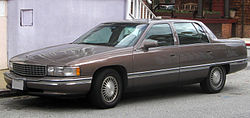
Production 1994–1999 Assembly Hamtramck, Michigan, USA Body style 4-door sedan Layout FF layout Platform K-body Engine 4.9 L L26 V8
4.6 L Northstar V8Transmission 4-speed 4T60 automatic
4-speed 4T80 automaticWheelbase 113.8 in (2,891 mm) Length 1994–96: 209.7 in (5,326 mm)
1997–99: 209.8 in (5,329 mm)Width 76.5 in (1,943 mm) Height 1994–96: 56.4 in (1,433 mm)
1997–99: 56.0 in (1,422 mm)Curb weight 3959 lb (1796 kg) For 1994, the DeVille was redesigned to share the K-body platform with the Seville. The body was redesigned, although the wheelbase remained 113.8"—rather than the 111" used on the Seville. Production moved to Hamtramck, Michigan. The name was shortened from Sedan de Ville to DeVille.
The DeVille Concours was available with the new 270 hp (201 kW) LD8 Northstar V8, while lesser models retained the 4.9L L26 V8 until 1996. That year, the base model took on the lower-output Northstar while the Concours moved up to the high-output L37 Northstar, with 300 hp (220 kW). The de Ville Concours replaced the 1993-only Cadillac Sixty Special.
The DeVille received a minor redesign for the 1997 model year, and added the d'Elegance trim line to replace the Cadillac Fleetwood. New headlights and a new grille were added, the rear wheel skirts were removed, the interior door handles were redesigned, and the black/chrome trim was replaced by a double chrome trim in the base de Ville, chrome and gold trim in the d'Elegance, and chrome and body colored trim in the Concours. The interior gained a new dashboard design that hid the passenger airbag seams and new door panels with front side-airbags and the availability of OnStar system. Production of this generation ended in July 1999. The appearance of this generation seems to have been an influence with the Mitsubishi Dignity sold only in Japan for a short time.
Model Year Engine Power Torque Base 1994–1995 4.9 L L26 V8 200 hp (149 kW) at 4100 rpm 275 ft·lbf (373 N·m) at 3000 rpm 1996–1999 4.6 L LD8 Northstar V8 275-300 hp (205 kW) at 5750 rpm 300 ft·lbf (373 N·m) at 4750 rpm Concours 1994 4.6 L LD8 Northstar V8 270 hp (201 kW) 300 ft·lbf (407 N·m) 1995 275 hp (205 kW) at 5750 rpm 275 ft·lbf (373 N·m) at 4750 rpm 1996–1999 4.6 L L37 Northstar V8 300 hp (224 kW) at 6000 rpm 295 ft·lbf (400 N·m) at 4400 rpm 2000–2005
Eleventh generation 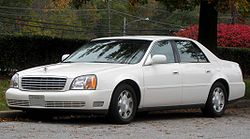
Production 2000–2005 Body style 4-door sedan Layout FF layout Platform K-body Engine 4.6 L Northstar V8 Transmission 4-speed 4T80 automatic Wheelbase 115.3 in (2,929 mm) Length 207.2 in (5,263 mm) Width 74.5 in (1,892 mm) Height 56.7 in (1,440 mm) Curb weight 3,800 lb (1,700 kg)+ The 2000 model year saw the first major redesign since 1994 and the introduction of the last generation of the DeVille. Production started in August 1999. The exterior was completely redesigned featuring a sportier, elegant and more aerodynamic design with a drag coefficient of 0.30. The revamped interior featured completely new door panels and seats, while the dashboard and radio face only received minor facelifts. The 2000 DeVille also featured the first production LED tail lamps in automobiles, a feature now becoming increasingly commonplace on luxury and family cars. The d'Elegance designation was replaced with the DeVille DHS (DeVille High Luxury), which added several cabin comfort options to include power rear window sunshade and heated/massaging rear seats. The performance DeVille Concours was renamed the DeVille DTS (DeVille Touring Sedan), and was available with stability control, active suspension, onboard navigation and magnetic variable assist steering.
This final version of the DeVille lasted through the redesign of 2000 and ended production in June 2005. It was replaced by the restyled and renamed DTS (stands for DeVille Touring Sedan) for 2006. This model was the first vehicle to use all LED tail lamps and night vision.[6]
Model Year Engine Power Torque Base / DHS 2000 4.6 L LD8 Northstar V8 275 hp (205 kW) at 5750 rpm 300 ft·lbf (373 N·m) at 4750 rpm 2002–2005 275 hp (205 kW) at 5600 rpm 300 ft·lbf (407 N·m) at 4000 rpm DTS 2000–2004 4.6 L L37 Northstar V8 300 hp (224 kW) at 6000 rpm 295 ft·lbf (400 N·m) at 4400 rpm 2005 290 hp (216 kW) at 5600 rpm 285 ft·lbf (386 N·m) at 4400 rpm 2006
Main article: Cadillac DTSIn 2006, the de Ville nameplate was replaced by Cadillac DTS, an initialism dating back to 1985, when a "de Ville Touring Sedan" package was available. The new name brought the de Ville into line with Cadillac's Art & Science-era nomenclature, which saw the Seville renamed to STS and the Catera replacement called the CTS. The last 2005 DeVille rolled off the Detroit/Hamtramck Assembly line on June 23, 2005.
See also
References
- ^ About Lincoln: The Roaring '20s
- ^ "1954 Cadillac". Motorera.com. November 2007. http://www.motorera.com/cadillac/cad1950/CAD54S.HTM. Retrieved 2008-04-06.
- ^ John Barach. "Cadillac history 1959". 100megsfree4.com. http://www.100megsfree4.com/cadillac/cad1950/cad59s.htm. Retrieved 2010-11-20.
- ^ John Barach (1964-09-25). "Cadillac history 1965". 100megsfree4.com. http://www.100megsfree4.com/cadillac/cad1960/cad65d.htm. Retrieved 2010-11-20.
- ^ John Barach. "Cadillac history 1971". 100megsfree4.com. http://www.100megsfree4.com/cadillac/cad1970/cad71d.htm. Retrieved 2010-11-20.
- ^ "What are LED taillights?". Ask.cars.com. 2008-09-16. http://ask.cars.com/2008/09/what-are-led-ta.html. Retrieved 2009-05-07.
External links
- AutoGuideWiki.com
- Caddyinfo.com - Cadillac Discussion and Technical Information
- Cadillac History - Cadillac History and detailed model information
- 1978-1979 Phaeton - 1978-1979 Cadillac Coupe de Ville Phaeton
Cadillac, a division of General Motors, road car timeline, 1930s–1970s — next » Type 1930s 1940s 1950s 1960s 1970s 0 1 2 3 4 5 6 7 8 9 0 1 2 3 4 5 6 7 8 9 0 1 2 3 4 5 6 7 8 9 0 1 2 3 4 5 6 7 8 9 0 1 2 3 4 5 6 7 8 9 Entry-level 60 61 61 WWII 61 355 70 62 Series 62 6200 Calais Mid-size Seville Full-size 65 Coupe de Ville/Sedan de Ville 60S Series 60S Fleetwood Brougham Limousine 355 67/72/75 Series 75 6700 Series 75 FL Limo Personal Luxury Eldorado Halo V-12 V-16 Eldorado Brougham « previous — Cadillac, a division of General Motors, road car timeline, 1980s–present Type 1980s 1990s 2000s 2010s 0 1 2 3 4 5 6 7 8 9 0 1 2 3 4 5 6 7 8 9 0 1 2 3 4 5 6 7 8 9 0 1 2 Compact executive Cimarron BLS Mid-size Catera CTS CTS CTS-V CTS-V Seville Seville Seville Seville STS STS-V Full-size Coupe de Ville/Sedan de Ville Coupe de Ville/Sedan de Ville DeVille DeVille DTS Fleetwood Series 60S Fleetwood Brougham Brougham Fleetwood Limousine Fleetwood Limousine Series 75 Personal luxury Eldorado Eldorado Eldorado Crossover SRX SRX SUV Escalade Escalade Escalade SUT Escalade EXT Escalade EXT Roadster Allanté XLR Categories:- Cadillac vehicles
- Front wheel drive vehicles
- Rear wheel drive vehicles
- Full-size vehicles
- 1940s automobiles
- 1950s automobiles
- 1960s automobiles
- 1970s automobiles
- 1980s automobiles
- 1990s automobiles
- 2000s automobiles
- Vehicles introduced in 1949
- Motor vehicles manufactured in the United States
Wikimedia Foundation. 2010.


